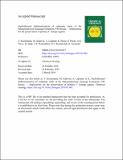Hydrothermal dedolomitisation of carbonate rocks of the Paleoproterozoic Zaonega Formation, NW Russia — Implications for the preservation of primary C isotope signals
Abstract
The Paleoproterozoic Zaonega Formation in Karelia, NW Russia, has played a key role in understanding the environmental conditions postdating the Great Oxidation and Lomagundi-Jatuli Events. Its carbonate- and organic-rich rocks (shungite) define the postulated Shunga Event representing an accumulation of very organic-rich sediments at c. 2 Ga and are central in ideas about changing ocean-atmosphere composition in the wake of those worldwide biogeochemical phenomena. Our work focussed on a key interval of carbonate rocks in the upper part of the Formation to: (i) obtain new high-resolution carbon, oxygen and strontium isotope data complemented by detailed petrography and mineralogical characterisation and (ii) expand upon previous studies by using our data to constrain geochemical modelling and show in greater detail how magmatic hydrothermal fluids induced dedolomitisation and altered geochemical signals. Our findings show that the δ13Ccarb of calcite-rich intervals are the most altered, with values between −16.9 to 0.6‰, whereas the dolomite-dominated parts retain the best-preserved (i.e. most original) values. Those define a trend of steadily increasing δ13Ccarb, from −6 to +0.5‰, which we interpret as a return to normal marine conditions and carbonate‑carbon values following the Lomagundi-Jatuli Event.
Citation
Kreitsmann , T , Külaviir , M , Lepland , A , Paiste , K , Paiste , P , Prave , A R , Sepp , H , Romashkin , A E , Rychanchik , D V & Kirsimäe , K 2019 , ' Hydrothermal dedolomitisation of carbonate rocks of the Paleoproterozoic Zaonega Formation, NW Russia — Implications for the preservation of primary C isotope signals ' , Chemical Geology , vol. 512 , pp. 43-57 . https://doi.org/10.1016/j.chemgeo.2019.03.002
Publication
Chemical Geology
Status
Peer reviewed
ISSN
0009-2541Type
Journal article
Description
This study was supported by Estonian Science Agency project PUT696 and PRG447, and Estonian Centre of Analytical Chemistry. K.P. and A.L. were supported by the Research Council of Norway through its Centres of Excellence funding scheme grant No. 223259.Collections
Items in the St Andrews Research Repository are protected by copyright, with all rights reserved, unless otherwise indicated.

